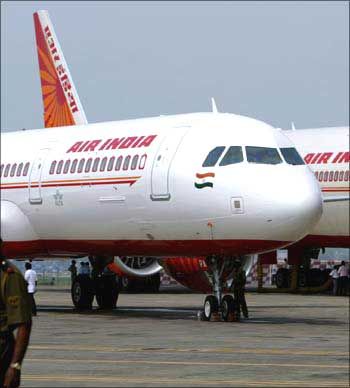 | « Back to article | Print this article |
 The DGCA would look into the tariff structure of Indian airlines in view of the wide range of the base prices of air tickets, after the Supreme Court observed that the price bands were too wide and directed it to examine the matter.
The DGCA would look into the tariff structure of Indian airlines in view of the wide range of the base prices of air tickets, after the Supreme Court observed that the price bands were too wide and directed it to examine the matter.
Efforts would be made to compress these price bands, which range from 12 to as high as 22 set by different airlines on each sector, and make air fares more transparent so that the travelling public are clear about the cost of travel, official sources said.
While there was a need to make the price bands more transparent, there should also be some rationale behind the huge differences between the highest and the lowest air fares in these price bands, they said.
Justifying the higher price bands, airline industry sources said that they have to take into account, apart from the actual costs of air travel, the variable costs on inputs like jet fuel, whose prices continue to rise, and staff costs.
While the Airlines Passengers Association of India (APAI) has welcomed the apex court's directions, some aviation experts have also objected to the inclusion of congestion charges or extra charges of Rs 50 for giving a printout of the ticket.
"When most airlines are showing high on-time performance, then why should they charge congestion charges," asked Debashish Saha of the Aeronautical Society of India.
Giving an example, he said there used to be severe congestion earlier at the IGIAirport with planes hovering for 30 minutes before being cleared to land.
"Now it has three operational runways and there are generally no delays, barring the foggy days. Then what is the justification for the congestion charge," he asked.
Regarding the price for a ticket printout, Saha said under the Carriage by Air Act, it is the contractual obligation of an airline to provide a ticket to the passenger. "Why should an extra fee be levied?"
The Carriage by Air Act of 1972, in the section 'Documents of Carriage', says that "for the carriage of passengers, the carrier must deliver a passenger ticket" with details like the place and date of issue, the departure place, the destination and name of the carrier or carriers.
Expressing concern over the massive differential between the lowest and highest air fares, the Supreme Court had on Wednesday directed the DGCA to examine the tariff structure of the airlines, observing that there were several price bands for fixing the base price for an air ticket.
"We are of prima facie view that regarding wide range of basic fair, it would be necessary for the DGCA to examine the tariff structure of the airlines," the bench had observed. It had also restrained Indian carriers from levying transaction fee in any form.
While most of the major carriers have 13-14 fare levels on most sectors, no-frill carrier GoAir has as many as 22 one-way basic fares ranging from Rs 3,770 to Rs 24,200 for one-way travel between Delhi and Mumbai in December last year.
Its no-frill competitor IndiGo's tickets ranged from the lowest of Rs 3,770 to the highest level of Rs 16,449, while SpiceJet's was Rs 3,770 and Rs 15,489.
On the same sector in the same month, Air India charged the lowest fare of Rs 3,920 and the highest of Rs 17,308, while the fares of Jet Airways ranged from Rs 3,970 to Rs 23,950. Similarly, Jet Konnect fares on Delhi-Mumbai sector was Rs 3,970 and Rs 24,100.
Over and above these basic fares, a passenger also has to pay a passenger service fee, airport charges and a fuel surcharge.